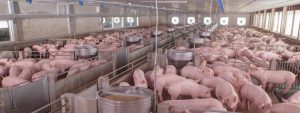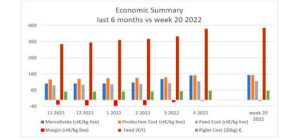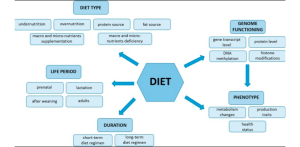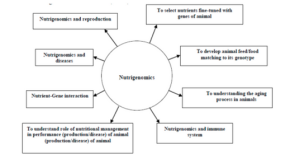 04 Jul 2022
04 Jul 2022
Nutrigenomics presents itself as a multidisciplinary science that offers a great array of potential benefits for current pig production.
Pig production: Current status and global context
Pig production systems, are currently affected by various factors, that have significant influence on production processes. Some of these include: swine diseases, risks of new pandemics, high population density in many countries, climate variability (periods of excess rainfall, prolonged droughts), crop stocks, activity of international grain markets, and the price volatility of various raw materials and feed additives used to produce animal diets. Rising energy costs, financial interest rates, and armed conflicts with global impacts are also influential factors in the stability and the growth potential of the pig industry.

The closing of farms due to African swine fever, as well as the abrupt reduction of poultry stocks due to avian influenza have put great pressure on the food and animal protein industries. This added to the low purchase power of the vast majority of humanity means that meat consumption is very volatile and represents a somewhat uncertain market.
Apparently in the 1st half of 2022 the international prices of pork are very attractive for the sale of product, but with great volatility, counterproductively and simultaneously there is a greater increase in the cost of inputs and services, mostly imported grains. With the inflation, devaluation and reduction of the market that is occurring worldwide, in the medium term the general contraction of the meat consumer market is unknown.
Many argue that for the time being it is not advisable to increase the number of sows in production. Even arguing that reducing current animal stocks would be beneficial. This uncertainty is erroneously attributed to transitory inflation while there is a simultaneous scenario of what is not clearly defined as post-pandemic recovery or a stage of recession due the war between Russia and Ukraine.
Table 1. Market activity from November 2021 – March 2022

At t he beginning of 2022, Chinese pig farming had been recovering its breeding stockpiles from a severe depopulation (2020-2021) due to African swine fever (ASF). As a result it has reduced its pork imports. However on March 2022 due to the seventh Omicron outbreak an important city were one of the largest pig production companies is located was once again shut down. Due to new restrictions, the amount of workers was significantly reduced causing important production losses. Under this scenario of uncertainty there is no room for speculation regarding how the international market will respond and what will be duration of its impact.
he beginning of 2022, Chinese pig farming had been recovering its breeding stockpiles from a severe depopulation (2020-2021) due to African swine fever (ASF). As a result it has reduced its pork imports. However on March 2022 due to the seventh Omicron outbreak an important city were one of the largest pig production companies is located was once again shut down. Due to new restrictions, the amount of workers was significantly reduced causing important production losses. Under this scenario of uncertainty there is no room for speculation regarding how the international market will respond and what will be duration of its impact.
Animal protein vs alternative protein sources
The presence of alternative protein sources such as synthetic meat are a rising trend. It is estimated that in the immediate future approximately by the second decade of the 20’s this type of product will cover 10% of the world’s protein consumption. This is quite a significant projection considering that 7% of the world’s population argues that animal protein should not be consumed. Jewish and Muslim religions (Islam, Mohammedan, other Arabs do not eat pork or pork by/products). Therefore this synthetic protein source offers an alternative to those who reject meat consumption.
This trend on the other hand does not supplant traditional agriculture. livestock and fishing industries. Yet it does highlight a new shift in preferences from a certain consumer groups. This trend is not completely new, as already in the 70’s attempts of manufacturing meat substitutes based on petroleum derivatives had been carried out. Subsequently, meat flavored products based on the use of soybean meal were created.
No matter on what side of the discussion one may stand, the world’s growing population of nearly 8 billion people and the need to find sustainable food sources that meet its demands is unquestionable. Establishing a significant responsibility from different players involved in food production, amongst which pig producers play a big role and will continue to do so.

The main purpose of this article is to motivate the reader to reflect on the current changes in nutritional requirements that can contribute to the economic sustainability of pig production around world. it is far from being a a comprehensive literature review on nutrigenomics or the genomic composition of current pig herds. The content within this publication may seem somewhat general, focusing only on those aspects that the authors considered worth highlighting. That does not mean that other topics regarding nutrigenomics and livestock production are less important or that they should not be reviewed with greater depth.
Importance of new technologies and trends in pig farming
In order for pig farmers to sustain themselves within the industry their productive activities must adapt to constant economic and commercial variations. Pig farm employees must receive ongoing training in order to have updated knowledge on new technologies and how to apply these in the field in favor of improving productivity levels. At the same time, it is important for producers to recognized the importance of attracting qualified professional, administrative and technical farm labor talent. As this will contribute significantly to achieving the goal of improving productive parameters.

Following diferents paths
Many will ask themselves which is be the best path for achieving sustainable pig production systems? One approach can be strictly technological, focusing on adopting cutting edge technologies while disregarding biological and zootechnical aspects of production, or attributing very little importance to them. On the other hand, another approach is to focus on understanding the physiological need of pigs in order to try to meet them in the best possible way. With the final purpose of obtaining high quality products that meet consumer demands in regards to food safety, and health. As now more than ever, healthy diets are high up on the list of consumer demands.
With the twentieth century began selections of genetic lines with pedigree giving rise in the 60’s to the brands of breeders. By improving the information recording processes, the best blup unbiased linear prediction was selected. With this, live births went from 10 to 15 piglets per litter. The weight increase in 1980 was 0.580 kg per day and by 2016 it reached 0.730 Kg/day. Both modern and ancient trends need to be sustainable to be in the meat market.
Nutrigenomics: a promising field for boosting pig production
The search for productive optimization, and improved yields has given way to various disciplines, amongst which nutrigenomics is one that holds great potential. It is considered as a multidisciplinary science that studies of the impacts and influence of nutrition on the genome. Genes can be turned on and off according to metabolic signals that the nucleus receives from internal factors, such as hormones, and also by external factors like nutrients. The latter are considered as some of the most significant environmental stimuli.
Figure 1. Diet and its genomic effects

Early in evolutionary development, organisms ingested nutrients which served as primitive signals that triggered or shut down synthesis pathways or storage mechanisms during periods of starvation or excess. Organisms evolved into more complex forms of life, but they retained the capacity to respond to nutrient or nutrient/hormonal signals that govern the expression of genes encoding the proteins of energy metabolism, cell differentiation and cell growth.
Nutrigenomics does not alter DNA or modify genes; it uses them to turn them on or identify their participation in biochemical cycles by means of selective nutrition or turning off the expression of unwanted genes. There are free radicals that protect from diseases by acting as antioxidants, others are powerful molecules that have a hormonal action or are health modulators. Certain phytochemicals modify the transcription of DNA information and transfer RNA from genes into the cell nucleus. Using bran in the diet there is an effect on the content of betaine in the blood plasma, you can know its elimination and that of creatinine, with it the quality of the food.
Figure 2. Nutrigenomics

This article will be continued with a complimentary publication…
Source: Modified from “21st Century Advances in Porcine Nutrigenomics”. Fernando R. Feuchter A. UNIVERSIDAD AUTÓNOMA CHAPINGO. Centro Regional Universitario del Noroeste
Subscribe now to the technical magazine of animal nutrition
AUTHORS

Nutritional Interventions to Improve Fertility in Male Broiler Breeders
Edgar O. Oviedo Rondón
The Use of Organic Acids in Poultry: A Natural Path to Health and Productivity
M. Naeem
Synergistic Benefits of Prebiotics and Probiotics in Poultry, Swine, and Cattle
Gustavo Adolfo Quintana-Ospina
Hybrid Rye Potential in Laying Hen Feed Rations
Gwendolyn Jones
A day in the life of phosphorus in pigs: Part I
Rafael Duran Giménez-Rico
Use of enzymes in diets for ruminants
Braulio de la Calle Campos
Minerals and Hoof Health in the Pregnant Sow
Juan Gabriel Espino
Impact of Oxidized Fats on Swine Reproduction and Offspring
Maria Alejandra Perez Alvarado